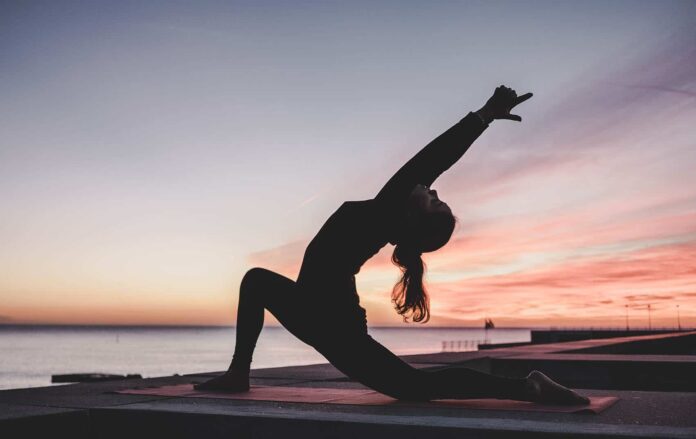Yoga is an ancient practice originating in India and referenced in texts that date back to 3000BCE. Surfing is an ancient Polynesian pastime, first documented by explorers like Captain Cook upon observing canoe surfing in Tahiti and other Pacific isles.
Yoga involves breathing, stretching, balancing and deliberate periods of stillness. The benefits are widely documented and include increased strength, flexibility, pain relief and reduced stress. Hot yoga – also called Bikram Yoga – is a series of 26 postures repeated in the exact same sequence each session. The room is heated to 105 degrees Fahrenheit (or thereabouts) with around 40 per cent humidity. Participants enter the studio and position themselves in front of a floor to ceiling mirror. When the instructor enters, the yogis stand up and the session begins.
Meet Stephanie Olver who owns Mount Yoga – New Zealand’s longest-running hot yoga studio, located in Mount Maunganui, Bay of Plenty.
Benefits of hot yoga for surfers
As a surfer, there are a range of benefits in developing increased flexibility and strength. While many surfers say that surfing is the best training for surfing there are times when surfing is impossible. Yoga can be practised anywhere, anytime. There are plenty of videos that will help you through the sequences. Hot yoga will require visiting a studio or a well-heated room in your home. I find visiting a studio forces you to persevere and stick with the session. At home, it is way too easy to get distracted or condense the session down to your favourite few postures.
Here are some of the benefits of hot yoga for surfers.
1. Improves posture
There’s nothing like a full-length mirror to highlight poor alignment. Practitioners of hot yoga are forced to confront themselves face-on and to make subtle real-time adjustments to improve their form. This process helps participants to unlearn bad habits and get used to activating muscles that improve alignment. Many people notice their shoulders are not straight or that they lean more heavily on one foot than the other.
To improve posture focus on:
- Ardha-Chandrasana (Half-Moon Pose). This is the second pose in the sequence and while it looks relatively easy can be one of the most intense stretches when done properly. Instead of just flopping to one side the goal is to pull your opposite side up and over you. Notice the difference between sides and the tendency to twist forward or back. Breathe naturally, make tiny adjustments and keep your eyes on yourself.
- Trikanasana (Triangle Pose). Triangle is without doubt one of the most intense poses in yoga. To check posture take a quick look at the mirror (from the side) and notice if your knees, hips or shoulders are out of alignment. Adjust as necessary. Triangle begins with a warrior-style stance before wheeling the body down towards the floor. It’s easy to see the benefits in terms of leg strength for surfers who stand on their boards in similar (though less wide) stances.

2. Build flexibility
Many people think yoga is all about extreme flexibility. It’s not. Bikram balances strength, flexibility and endurance. The outcome of consistent practice will include increased flexibility but that’s not the goal, so ditch any preconceptions before walking into the studio. And don’t worry, there’s no chanting, crystals or super-advanced yoga twists in the hot room – you’re in for a seriously practical workout.
You’ll notice the benefits in your hips when bottom and top turning.
Supporting postures are:
- Pada-Hastasana (Hands to Feet). This is an incredible antidote to the hyperextended back posture required when paddling a surfboard. It stretches the entire back side of the body.
- Supta-Vajrasana (Fixed Firm Pose). The opposite of Hands to Feet, this stretches out the quads and increases flexibility in the chest and shoulders. It feels really good.

3. Improve back strength
An important aspect of the Bikram sequence is that you balance back bends with forward bends. Surfers spend way more time than most people in a highly unnatural hyperextended position while paddling. Neck and back pain is almost guaranteed for lifelong surfers. Many surfers report scoliosis – like Mick Fanning’s early and almost debilitating condition – while some may even experience Surfer’s Myelopathy – a rare condition causing paralysis.
Keep your back strong by balancing the ubiquitous paddle posture with a range of supporting exercises designed to increase full back strength. Focus on:
- Sasangasana (Rabbit Pose). An amazing forward fold that creates space between the vertebrae.
- Salabasana (Locust Pose). Activate the upper back muscles and enjoy a posture that helps with back pain.

4. Improve proprioception
Proprioception is your sense of balance. In my experience, consistent yoga practice is one of the best ways to improve proprioception, enabling more dynamic and adaptive surfing. Even after time out of the water you’ll be less rusty if you’ve been practicing some of the postures available in hot yoga.
Focus on:
- Dandayamana-Janushirasana (Standing Head to Knee Pose). This is perhaps one of the most challenging postures, requiring strength, balance and focus. It is also an excellent progress measurement as you’ll notice improvement quickly.

- Dandayamana-Dhanurasana (Standing Bow Pulling Pose). Another single-leg balance posture requiring focus and persistence. One of the highest intensity poses of the sequence – it will leave your heart thumping.
5. Test your limits
Hot yoga is not easy. It’s probably more challenging than 90% of surfing experiences. The process of homeostasis guides most life forms on earth to seek comfort over distress. Think of it this way: you get hot, then homeostasis triggers action – to go and open a window. This action is impossible in a hot yoga studio. You’re locked in for the 60 – 90 minute session with nowhere to go but into the depths of your undoubtedly busy mind. You’ll learn a lot about yourself and your inner chatter during this relatively short time.
It is good for us to experience active distress. To push the limits and realise that what seemed impossible is actually just a mindset. Hot yoga challenges your version of reality and trains the body to endure discomfort. You develop a new baseline. Your homeostasis may eventually crave the hot room.
6. Learn to hold your attention
When the mind wanders in hot yoga you make mistakes. You’ll feel wobbly or miss an important cue. Yoga is often touted as a form of meditation or mindfulness and it deserves all the recognition it gets. If nothing else, you’ll find a reprieve from life’s busyness within the confines of studio. Enjoy being disconnected. No phone, no email, no social media, no meetings, no obligations. Just you, your body and your thoughts.
In the rest periods, whilst lying in Savasana (corpse pose), your mind may start to drift but keep your eyes open. Focus on a single spot on the ceiling and make that spot your whole world. Breathe your way into the present. Enjoy the scientifically proven benefits of meditation. You’ll develop increased attention control that will make you a better surfer and a more focused person.
7. Heat shock
Much has been written about hyperthermic conditioning and the benefits both for athletic performance and everyday wellbeing. Some clear benefits of heat exposure are explained by Dr Rhona Patrick in an interview with Tim Ferriss. These include increased Growth Hormone release, neurogenesis (production of new brain cells), antioxidant effect that protects cells, muscle repair and growth.
8. Cardiovascular fitness
You might not consider yoga to be on par with an activity like jogging in terms of developing cardiovascular fitness but prepare to be surprised. Just like jogging or paddling a canoe, you can consider hot yoga a moderate to high intensity workout that will push your heart to somewhere between 60 and 80 percent of your maximum. The beauty of the practice is that the better you get, the harder you work. It never gets easier – you just get stronger.
If you’re unable to surf for a while, hot yoga is a great way to maintain a level of cardio fitness in addition to strength and flexibility.
9. Cross training improves performance
Many would say that surfing is the best exercise to improve your surf performance and this is true. However, cross training helps you build up strength and flexibility in muscle groups that are neglected when performing the repetitive surfing motions – think long paddle outs. You’ll also improve your general conditioning, get the benefits of hyperthermic exposure and improve your focus.
Whether it is a way to proactively improve your surfing performance or to stay fit during those flat periods, hot yoga can and will make you a better surfer. If the hot room turns you off by all means try a normal yoga class. There are styles to suit every taste. The benefit of hot yoga is you get to track your progress because the sequence remains the same no matter where in the world you go.
Watch a full class in the video below.





